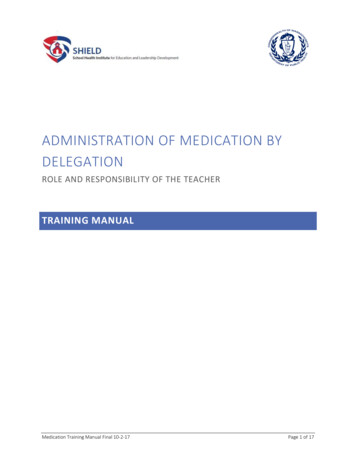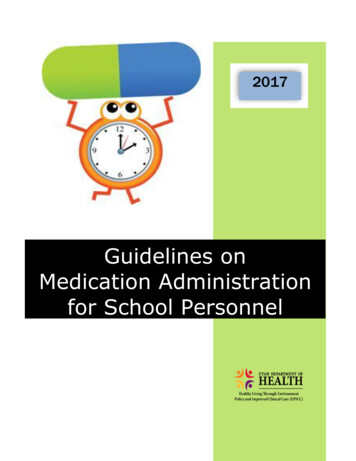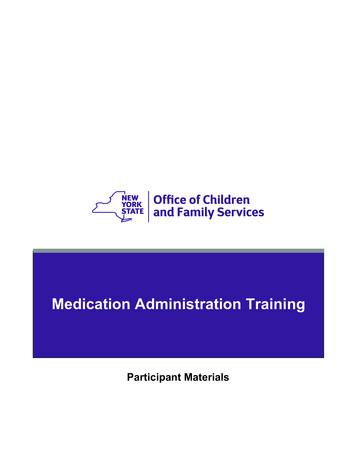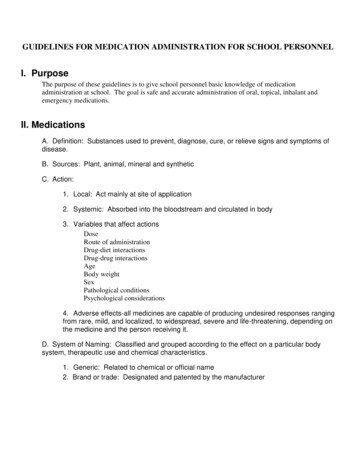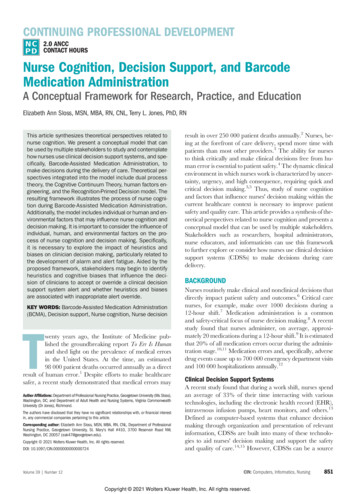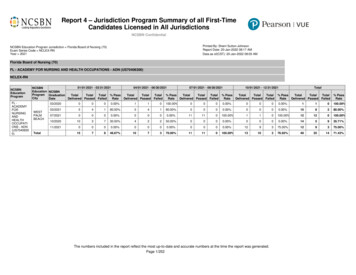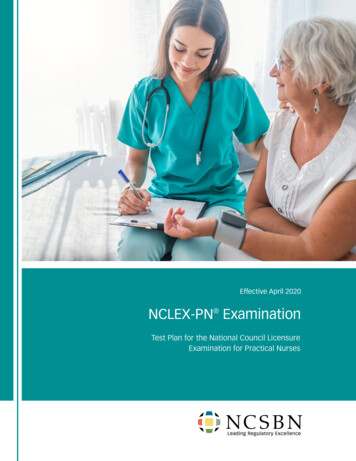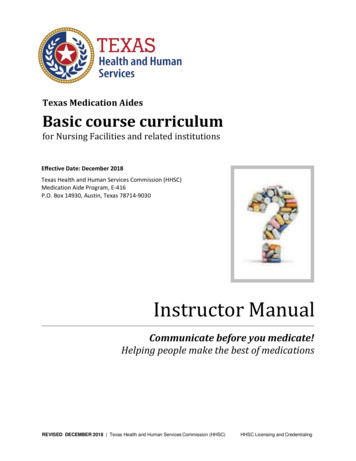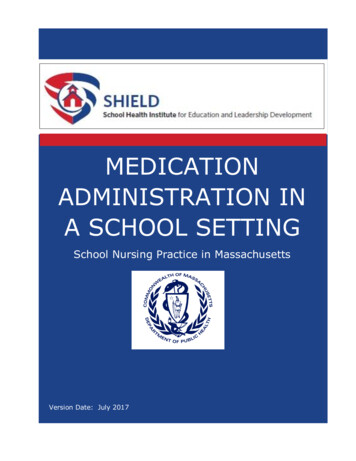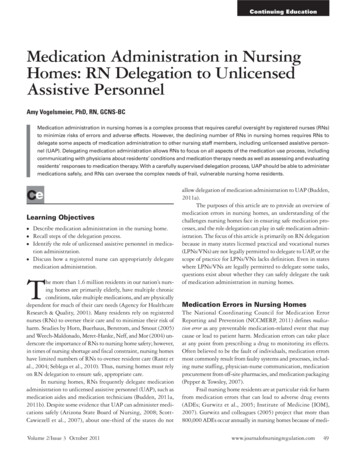
Transcription
Continuing EducationMedication Administration in NursingHomes: RN Delegation to UnlicensedAssistive PersonnelAmy Vogelsmeier, PhD, RN, GCNS-BCMedication administration in nursing homes is a complex process that requires careful oversight by registered nurses (RNs)to minimize risks of errors and adverse effects. However, the declining number of RNs in nursing homes requires RNs todelegate some aspects of medication administration to other nursing staff members, including unlicensed assistive personnel (UAP). Delegating medication administration allows RNs to focus on all aspects of the medication use process, includingcommunicating with physicians about residents’ conditions and medication therapy needs as well as assessing and evaluatingresidents’ responses to medication therapy. With a carefully supervised delegation process, UAP should be able to administermedications safely, and RNs can oversee the complex needs of frail, vulnerable nursing home residents.CeLearning Objectives Describe medication administration in the nursing home.Recall steps of the delegation process.Identify the role of unlicensed assistive personnel in medication administration.Discuss how a registered nurse can appropriately delegatemedication administration.The more than 1.6 million residents in our nation’s nursing homes are primarily elderly, have multiple chronicconditions, take multiple medications, and are physicallydependent for much of their care needs (Agency for HealthcareResearch & Quality, 2001). Many residents rely on registerednurses (RNs) to oversee their care and to minimize their risk ofharm. Studies by Horn, Buerhaus, Berstrom, and Smout (2005)and Weech-Maldonado, Meret-Hanke, Neff, and Mor (2004) underscore the importance of RNs to nursing home safety; however,in times of nursing shortage and fiscal constraint, nursing homeshave limited numbers of RNs to oversee resident care (Rantz etal., 2004; Seblega et al., 2010). Thus, nursing homes must relyon RN delegation to ensure safe, appropriate care.In nursing homes, RNs frequently delegate medicationadministration to unlicensed assistive personnel (UAP), such asmedication aides and medication technicians (Budden, 2011a,2011b). Despite some evidence that UAP can administer medications safely (Arizona State Board of Nursing, 2008; ScottCawiezell et al., 2007), about one-third of the states do notVolume 2/Issue 3 October 2011allow delegation of medication administration to UAP (Budden,2011a).The purposes of this article are to provide an overview ofmedication errors in nursing homes, an understanding of thechallenges nursing homes face in ensuring safe medication processes, and the role delegation can play in safe medication administration. The focus of this article is primarily on RN delegationbecause in many states licensed practical and vocational nurses(LPNs/VNs) are not legally permitted to delegate to UAP, or thescope of practice for LPNs/VNs lacks definition. Even in stateswhere LPNs/VNs are legally permitted to delegate some tasks,questions exist about whether they can safely delegate the taskof medication administration in nursing homes.Medication Errors in Nursing HomesThe National Coordinating Council for Medication ErrorReporting and Prevention (NCCMERP, 2011) defines medication error as any preventable medication-related event that maycause or lead to patient harm. Medication errors can take placeat any point from prescribing a drug to monitoring its effects.Often believed to be the fault of individuals, medication errorsmost commonly result from faulty systems and processes, including nurse staffing, physician-nurse communication, medicationprocurement from off-site pharmacies, and medication packaging(Pepper & Towsley, 2007).Frail nursing home residents are at particular risk for harmfrom medication errors that can lead to adverse drug events(ADEs; Gurwitz et al., 2005; Institute of Medicine [IOM],2007). Gurwitz and colleagues (2005) project that more than800,000 ADEs occur annually in nursing homes because of mediwww.journalofnursingregulation.com49
Table 1RN Responsibilities in the Nursing HomeMedication Use ProcessMedicationUse ProcessRegistered Nurse (RN) ResponsibilitiesPrescribingCommunicating with physicians aboutresidents’ medical condition and medication therapy needsTranscribingEnsuring accurate transcription and documentation of multiple medication orders and managing complicated medication orders through complex medicationorder processesDispensingCommunicating with off-site pharmaciesand ensuring accurate and timely delivery of medicationsAdministeringEnsuring safe administration of largevolumes of medications within time constraintsMonitoringAssessing and evaluating residents’ responses to medication therapy andmonitoring residents for adverse drugeventscation errors. Experts consider this number to be an underestimate (IOM, 2007).Pepper and Towsley (2007) report the most common nursing home medication errors are prescribing errors, includingwrong dose and inappropriate medication use, and medicationadministration errors, including omitted doses and wrong time.Excluding wrong-time errors, Barker, Flynn, Pepper, Bates, &Mikeal (2002) found more than 10% of doses administered tonursing home residents were in error. Monitoring errors are believed to be common in nursing homes, but they have not beenwell studied. Medication administration errors may relate inpart to the large number of medications nursing home residentsreceive. On average, residents receive seven to eight medications daily, and about one-third receive nine or more medications(Doshi, Shaffer, & Briesacher, 2005). Moreover, large numbersof medications are often administered multiple times per day,adding complexity to the medication administration process.Medication Administration in NursingHomesMedication administration in nursing homes is often considered a simple task of “passing medications.” However, in reality medication administration is a complex process requiringmany interactions of specific decisions and actions (Kaushal etal., 2001). Perhaps the complexity of medication administrationcan best be understood within nodes (or stages) of the medicationuse process. These five nodes include prescribing, transcribing,50Journal of Nursing Regulationdispensing, administering, and monitoring (NCCMERP, 2000;United States Pharmacopeia [USP], 2004).Prescribing involves evaluating the patient to establishmedication need and selecting the right medication to managethe condition, taking into consideration possible interactionsand allergies. Transcribing involves documenting the physician’smedication order and transmitting the order to the pharmacy.Dispensing involves reviewing the order and confirming the transcription accuracy, contacting the prescriber regarding discrepancies, preparing the medication, and dispensing the medicationto the health care site. Administering involves reviewing the orderand confirming transcription accuracy; checking for contraindications, such as allergies and interactions; assessing the patient;and administering the medication. Monitoring involves assessingthe patient’s response to the medication and documenting theresults (USP, 2004). Traditionally, physicians are responsible forprescribing medications, pharmacists for dispensing and monitoring medications, and nurses for administering medications.Despite the traditional view that the nurse’s primary responsibility is to administer medications, the nature and complexity of nursing home care require licensed nurses, particularlyRNs, to be involved in the entire medication use process. First,physicians are often not on site and must rely on communicationfrom nurses about residents’ medical condition and medicationtherapy needs (Vogelsmeier, Scott-Cawiezell, & Zellmer, 2007).Second, multiple medication orders and complicated medication ordering processes require careful communication to offsite pharmacies (Vogelsmeier et al., 2007). Third, the nursingstaff is responsible to ensure the appropriate and timely deliveryof medications from off-site pharmacies to the nursing home(Vogelsmeier et al., 2007). Fourth, nursing staff must ensureresidents receive multiple medications within tight regulatorytime constraints (Vogelsmeier et al., 2007); the average medication pass involves 73 medications and takes an average of 113minutes (Scott-Cawiezell et al., 2007). Fifth, pharmacists spendlimited time in nursing homes monitoring medication effects,making nurses responsible for assessing and evaluating complexresidents for therapeutic and adverse responses (Vogelsmeier etal., 2007). (See Table 1.)While these nursing home realities support the need forRNs to be involved in all aspects of the medication use process,the number of nursing home RNs has declined over the years,resulting in fewer and fewer RNs to oversee and manage care(Seblega et al., 2010). RNs now account for less than 14% of thenurses in nursing homes (Rantz et al., 2004). Thus, the role of theRN must be maximized through appropriate and safe delegation.RN DelegationRN delegation must be grounded in the fundamental principleto protect the health, safety, and welfare of the public. In an effortto support the practice of RN delegation while upholding the
tenet of patient safety, the National Council of State Boards ofNursing (NCSBN) and the American Nurses Association (ANA)joined to define delegation. According to the NCSBN and ANA,delegation is defined as an RN and in some states LPNs/VNs(Corazzini et al., 2011) having the authority to direct anotherindividual to perform nursing tasks and activities they wouldotherwise not be assigned (NCSBN, 2005). Delegation, however, is much more complex than it seems by mere definition;it requires a critical understanding of the steps in the delegation process and appropriate clinical training to delegate safely(NCSBN, 1995). (See Table 2.)Delegation requires individual nurse accountability andorganizational accountability to ensure safe care is delivered(NCSBN, 1995, 2005). A nurse is responsible for carefully considering the competencies of staff members, the condition of thepatient, and the degree of supervision required for safe care. Thenurse also must ensure adequate two-way communication withstaff members when delegating care. Moreover, the nurse mustmonitor organizational systems to ensure that safe, appropriatedelegation can be carried out. Organizations and nurse leaders,on the other hand, must ensure that adequate systems are in placeto support safe delegation, including adequate staff resources,clear documentation of staff competencies, and organizationalstandards developed with nurse input to define safe delegationactivities. Both individuals and organizations must adhere tothe delegation principles, including the five rights of delegation. (See Table 3.)Unlicensed Assistive PersonnelStates that allow UAP to administer medications have educational programs to establish competencies; however, these programsvary widely. In a review of medication-aide training programsacross the United States, Budden (2011a) found variation in applicant requirements, training, testing, and continuing educationhours. For example, some training programs require applicantsbe certified nursing assistants; others do not. Most require someform of work experience in long-term care. Didactic and clinicaltraining hours averaged 73.97; however, didactic training variedfrom 4 to 150 hours, and clinical training varied from 0 to 40hours. The majority of programs require written examinationafter training, and nearly one-third have a skills-demonstrationcomponent. Continuing education requirements vary from nocontinuing education to formal retraining every 2 years.Similar to variability in training programs, roles andresponsibilities vary among the UAP who administer medications in their workplace. Budden (2011b) conducted a surveyof medication aides (n 3,455) to identify relevant workplaceissues, such as work role and supervision. Medication administration responsibilities ranged from administering topical and oralmedications to regulating I.V. fluids and programming insulinpumps. Medication aides often administered medications, inVolume 2/Issue 3 October 2011Table 2Steps in the Delegation ProcessDelegationStepsDescriptionAssessmentand planningAssess and plan the delegation activitybased on the patient’s need andavailable resources, includingappropriate staff members.CommunicationCommunicate directions to thedelegated staff. Include patientrequirements and characteristics aswell as clear expectations regardingwhat to do, what to report, and whento ask for assistance.Surveillanceand supervisionProvide surveillance and supervisionof the delegation, including the level ofsupervision needed and theimplementation of the supervision.Include follow-up to problems or achanging situation.Evaluation andfeedbackEvaluate and provide feedback toconsider the effectiveness of thedelegation, including any need toadjust the plan of care.National Council of State Boards of Nursing, 2005.cluding as needed (prn) medications, without prior assessmentor follow-up monitoring by a licensed nurse. Many medicationaides also received medication orders from prescribers and transcribed the medication orders into the record. Supervision andnursing oversight were often limited. Many medication aideshad no supervision at all or no contact with a supervisor duringa typical shift. These issues identified by Budden reflect therealities in many nursing homes today.The Arizona State Board of Nursing (BON; 2008) soughtto develop a comprehensive standardized statewide medicationtechnician pilot program that supports safe delegation withinnursing homes. The program included course content based onthe complex realities of medication administration in nursinghomes. For example, the 100-hour curriculum included contenton administering large quantities of medications; working withintime constraints; crushing medications appropriately; calculating complicated dosage calculations; and working with various dispensing methods, administration methods, and residentmedication administration challenges such as resident refusals.Protocols further delineated the conditions under which delegation could and could not safely occur.In a study by Scott-Cawiezell et al. (2007), no differenceswere found in medication error rates when observing RNs, LPNs/VNs, and UAP. In fact, when wrong-time errors were excluded,RNs had slightly higher medication-error rates. The authorsthink the higher error rate is related to the number of interrup-www.journalofnursingregulation.com51
Table 3Five Rights of Delegation Right task: Task that is delegable for a specific patient/residentRight circumstances: Appropriate patient setting, available resources, and other relevant factorsRight person: Right person delegating the right task tothe right person to be performed on the right personRight direction/communication: Clear, concise description of the task, including its objective, limits, and expectationsRight supervision: Appropriate monitoring, evaluation,intervention, and feedbackNational Council of State Boards of Nursing, 2005.tions and distractions many RNs encounter during medicationadministration.RN and UAP Partnering for SafeMedicationIf medication administration is done by UAP, safe systems mustbe in place to support this role in practice. Ensuring a competent UAP staff requires the involvement of regulators, nursing home administrators/nurse leaders, and individual licensednurses (NCSBN, 1995, 2005).Regulatory involvement includes ensuring that statewidetraining programs establish UAP competencies and define andteach safe and unsafe medication administration activities. Forexample, the Arizona State BON’s training program not onlydefines safe parameters for administering medications, it alsodefines activities that are unsafe for UAP, including administering first doses, inhalant medications, injectable medications,and prn medications; regulating I.V. fluids; and programminginsulin pumps (Randolph & Scott-Cawiezell, 2010).Nursing home administrators and nurse leaders must ensure their UAP meet the state’s competence requirements andmust have documentation on site for reference by staff RNs.Moreover, nursing home leaders must make sure job descriptions and role responsibilities clearly match the competencies asestablished through statewide training. When job descriptionsand role responsibilities are clearly defined within an organization, all staff RNs, LPNs/VNs, and UAP will know what canand cannot be safely delegated.With standards in place, RNs have a responsibility tomake sure UAP are competent to administer medications, taking into account the complexities of individual resident needsat the time of delegation. Working within defined limits andcarefully considering individual resident needs can guide the safeadministration of medications by UAP. UAP can then focus onthe tasks they are competent to perform, thus freeing RNs to beinvolved in all aspects of the medication use process.52Journal of Nursing RegulationBecause all aspects of the medication use process are subject to medication error (NCCMERP, 2000; Pepper & Towsley,2007), RNs play a critical role in minimizing errors. RNs mustbe able to focus on medication assessment, monitoring, andevaluation to ensure residents are meeting their therapeuticgoals, while UAP focus on administering routine medicationsaccurately and on time.ConclusionMedication administration in nursing homes is a complex processthat requires a collaborative effort between RNs and UAP toensure safe medication administration. Delegating medicationadministration allows RNs to focus on all aspects of the medication use process, including communicating with physiciansabout residents’ conditions and medication therapy needs aswell as assessing and evaluating residents’ responses to medication therapy. Through a carefully supervised delegation process,UAP can administer medications safely, and RNs can overseethe complex needs of frail, vulnerable nursing home residents.ReferencesAgency for Healthcare Research & Quality. (2001). AHRQ Research Report. The Characteristics of Long-Term Care Users. AHRQ PublicationNo. 00-0049, January 2001. Rockville, MD: Author. Retrievedfrom www.ahrq.gov/research/ltcusers/Arizona State Board of Nursing. (2008). Report to the legislature: Arizona medication technician pilot project. Retrieved from THE%20LEGISLATURE.pdfBarker, K. N., Flynn, E. A., Pepper G. A., Bates, D. W., & Mikeal, R.L. (2002). Medication errors observed in 36 health care facilities.Archives of Internal Medicine, 162(16), 1897–1903.Budden, J. (2011a). The safety and regulation of medication aides. Journal of Nursing Regulation, 2(2), 1–6.Budden, J. (2011b). The first national survey of medication aides. Journal of Nursing Regulation, 2(3), 4–12.Corazzini, K. N., Anderson, R. A., Mueller, C., McConnell, E. S.,Landerman, L. R., Thorpe, J. M., et al. (2011). Regulation of LPNscope of practice in long-term care. Journal of Nursing Regulation,2(2), 20–39.Doshi, J. A., Shaffer, T., & Briesacher, B. (2005). National estimates ofmedication use in nursing homes: Findings from the 1997 Medicare current beneficiary survey and the 1996 Medicare expendituresurvey. Journal of the American Geriatric Society, 53, 438–443.Gurwitz, J. H., Field, T. S., Judge, J., Rochon, P., Harrold, L. R., Cadoret, C., et al. (2005). The incidence of adverse drug events in twolarge academic long-term care facilities. The American Journal ofMedicine, 118(3), 251–258.Horn, S., Buerhaus, P., Berstrom, N., & Smout, R. J. (2005). RN staffing time and outcomes of long-stay nursing home residents. American Journal of Nursing, 105, 58–70.Institute of Medicine. (2007). Preventing medication errors. Washington,DC: National Academies Press.
Kaushal, R., Bates, D. W., Landrigan, C., McKenna, K. J., Clapp, M.D., Federico, R., et al. (2001). Medication errors and adverse drugevents in pediatric inpatients. Journal of the American Medical Association, 285(16), 2114–-2120.National Coordinating Council for Medication Error Reporting andPrevention. (2011). About medication errors. Retrieved fromwww.nccmerp.org/medErrorCatIndex.htmlNational Coordinating Council for Medication Error Reporting andPrevention. (2000). Aiming at administering: Practice recommendations to prevent error. USP Quality Review, 71, 1–2.National Council of State Boards of Nursing. (1995). Concepts and decision-making process. Retrieved from www.ncsbn.org/323.htmNational Council of State Boards of Nursing. (2005). Joint statementon delegation. American Nurses Association/National Council ofState Boards of Nursing. Retrieved from www.ncsbn.org/Jointstatement.pdfPepper, G. A., & Towsley, G. L. (2007). Medication errors in nursinghomes: Incidence and reduction strategies. Journal of PharmaceuticalFinance, Economics, & Policy, 16(1), 5–133.Randolph, P. K., & Scott-Cawiezell, J. (2010). Developing a statewidemedication technician pilot program in nursing homes. Journal ofGerontological Nursing, 36(9), 36–44.Rantz, M. J., Hicks, L., Grando, V., Petroski, G. F., Madsen, R. W.,Mehr, D. R., et al. (2004). Nursing home quality, cost, staffingand staff mix. The Gerontologist, 44, 24–38.Scott-Cawiezell, J., Pepper, G., Madsen, R., Petroski, G. Vogelsmeier,A., & Zellmer, D. (2007). Nursing home error and level of staffcredentials. Clinical Nursing Research, 16(1), 72–79.Seblega, B. K., Zhang, N. J., Unruh, L. Y., Breen, G. M., Paek, S. C., &Wan, T. H. (2010). Changes in nursing home staffing levels, 1997to 2007. Medical Care Research Review, 67(2), 232–246.United States Pharmacopeia. (2004). The medication use process. Retrieved from ess.pdfVogelsmeier, A., Scott-Cawiezell, J., & Zellmer, D. (2007). Barriers tosafe medication administration in the nursing home. Journal of Gerontological Nursing, 33(4), 5–12.Weech-Maldonado, R., Meret-Hanke, L., Neff, M. C., & Mor, V.(2004). Nurse staffing patterns and quality of care in nursinghomes. Health Care Management Review, 29, 107–116.Amy Vogelsmeier, PhD, RN, GCNS-BC, is an assistantprofessor and John A. Hartford Claire M. Fagin Fellowat Sinclair School of Nursing, University of Missouri inColumbia.Volume 2/Issue 3 October 2011www.journalofnursingregulation.com53
PosttestMedication Administrationin Nursing Homes: RNDelegation to UnlicensedAssistive PersonnelLearning ObjectivesDescribe medication administration in the nursing home. Recall steps of the delegation process. Identify the role of unlicensed assistive personnel in medicationadministration. Discuss how a registered nursecan appropriately delegate medication administration. CeCE PosttestMedication Administration inNursing Homes: RN Delegation toUnlicensed Assistive PersonnelIf you reside in the United States andwish to obtain 1.4 contact hours ofcontinuing education (CE) credit,please review these instructions.InstructionsGo online to take the posttest andearn CE credit:Members – www.ncsbninteractive.org (no charge)Nonmembers – www.learningext.com ( 15 processing fee)If you cannot take the posttestonline, complete the print form andmail it to the address (nonmembersmust include a check for 15,payable to NCSBN) included atbottom of form.Provider accreditationThe NCSBN is accredited as aprovider of CE by the Alabama StateBoard of Nursing.The information in this CE does notimply endorsement of any product,service, or company referred to in thisactivity.Contact hours: 1.4Posttest passing score is 75%.Expiration: October 201454Journal of Nursing RegulationPlease circle the correct answer.1. What is the average number ofmedications a nursing home residentreceives daily?a. 2 to 4b. 5 to 6c. 7 to 8d. 10 to 122. Excluding wrong-time errors, thepercentage of doses administered tonursing home residents that is wrong is:e. 2%.f. 5%.g. 10%.h. 12%.3. The stages of the medication useprocess include:a. monitoring.b. checking.c. counting.d. reporting.8. What term is defined as “an RN and insome states LPNs [licensed practicalnurses] having the authority to directanother individual to perform nursingtasks and activities they wouldotherwise not be assigned”?a. Delegationb. Monitoringc. Assigningd. Prescription9. The step in the delegation process thatincludes follow-up to problems or achanging situation is:a. evaluation and feedback.b. surveillance and supervision.c. communication.d. assessment and planning.10. The step in the delegation process thatincludes determining the need to adjustthe plan of care is:a. evaluation and feedback.b. surveillance and supervision.c. communication.d. assessment and planning.4. Which statement about responsibilitiesin the medication use process in nursinghomes is correct?a. Unlicensed assistive personnel (UAP) areresponsible for ensuring timelyadministration.b. The physician communicates directlywith the pharmacy.c. The on-site pharmacist is responsible forverifying dosages.d. The registered nurse (RN) must evaluateresidents’ responses to medicationtherapy.11. Which “right” of delegation includesavailable resources?a. Taskb. Supervisionc. Circumstancesd. Direction5. The average medication pass in thenursing home involves how manymedications?a. 48b. 52c. 73d. 8113. Which statement about medication-aidetraining is correct?a. Application requirements, training,testing, and continuing education varywidely.b. Application requirements and trainingvary widely, but testing and continuingeducation are standardized.c. Retraining is required every 2 years.d. Retraining is required every 4 years.6. Which statement about licensed healthcare professionals and the medicationuse process in nursing homes is correct?a. RNs are only responsible foradministering medications.b. RNs are involved in the entire process.c. Physicians play a more active role inmedication administration.d. Pharmacists closely evaluate residentsfor adverse effects.7. RNs account for what percentage ofnurses in nursing homes?a. 24%b. 35%c. Less than 9%d. Less than 14%12. Which “right” of delegation includesobjectives, limits, and expectations?a. Taskb. Supervisionc. Circumstancesd. Direction14. According to research, which statementabout medication aides’ roles andresponsibilities is correct?a. Medication aides are not permitted toadminister topical medications.b. Medication aides do not administeras-needed medications without priorassessment.c. Many medication aides have little to nosupervision.d. Most medication aides have contact witha supervisor twice a shift.
15. Which statement about RNs andmedication aides is correct?a. RNs should focus on transcribing anddispensing, while medication aidesshould focus on administering routinemedications.b. RNs should focus on medicationassessment, monitoring, and evaluation,while medication aides should focus onadministering routine medications.c. RNs should focus on medicationassessment, monitoring, and evaluation,while medication aides should focus onadministering complicated medicationregimens.d. RNs should focus on dispensing andcalculating, while medication aidesshould focus on administering oral,intramuscular, and intravenous drugs.16. Nursing home administrators should:a. ensure UAP who administer medicationsmeet the state competency requirements.b. directly supervise UAP who administermedications to reduce errors.c. keep job descriptions and roleresponsibilities for RNs and UAP whoadminister medications general in scope.d. keep off-site documentation of thecompetence of UAP who administermedications.17. Which statement about the regulatoryissues related to UAP administeringmedications is correct?a. State boards of medicine should assumeresponsibility for UAP regulation.b. State boards of nursing (BONs) shouldnot list what drugs UAP cannotadminister.c. Each state BON should create a uniquetraining program.d. State BONs should define what is neededin training programs.Evaluation Form (required)Rate each of the following items from5 (very effective) to 1 (ineffective):2. Were the authors knowledgeable aboutthe subject?1. Rate your achievement of eachobjective from 5 (high/excellent)to 1 (low/poor). 1 345234523423434523454. Was the content relevant to theobjectives?123455. Was the article useful to you in yourwork?5Discuss how a registered nursecan appropriately delegate medication administration.123. Were the methods of presentation (text,tables, figures, etc.) effective?1Identify the role of unlicensed assistive personnel in medicationadministration.1 2Recall steps of the delegation process.1 1Describe medication administration in the nursing home.123456. Was there enough time allotted for thisactivity?152345Comments:Please print clearlyNameMailing addressStreetCityStateZipHome phoneBusiness phoneFaxE-mailMethod of payment (check one box) Member (no charge) Nonmembers (must include a check for 15 payable to NCSBN)PLEASE DO NOT SEND CASH.Mail completed posttest, evaluation form, registration form, and payment to:NCSBNc/o Beth Radtke111 East Wacker DriveSuite 2900Chicago, IL 60601-4277Please allow 4 to 6 weeks for processing.Volume 2/Issue 3 October 2011www.journalofnursingregulation.com55
Second, multiple medication orders and complicated medica-tion ordering processes require careful communication to off-site pharmacies (Vogelsmeier et al., 2007). Third, the nursing . Transcribing ensuring accurate transcription and doc-umentation of multiple medication or-ders and managing complicated medica-tion orders through complex .
